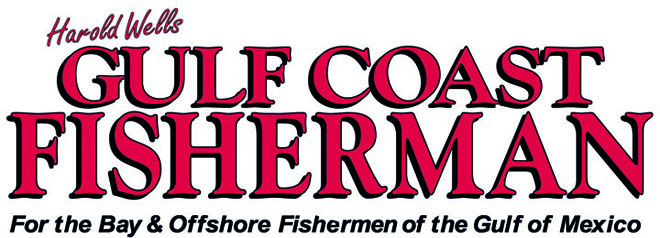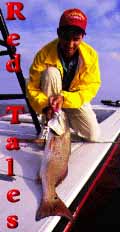
The Saltwater Magazine for Gulf Coast Fishing!
FISHING FORECASTS
| FISHING CALENDARS | ARTICLES | ADVERTISE
| SUBSCRIBE
Matagorda Island's Pringle Lake
Search Gulf Coast Fisherman's
Web Site
Past articles, specific
places or fish, etc.


![]()
Just
off Vanderveer Island at Port O'Connor, Texas is a tiny opening leading
the way into Pringle Lake. I've been slipping through that opening
since about 1970 and for good reason - excellent fishing for reds and trout.
One of the most successful days of fishing I've ever had on saltwater took place on Pringle. Two friends and I had scooted through the channel and into the lake on a hot summer day. We were in a 16 foot shallow running Kenner and skimmed through the narrow channel and into the lake without running aground, which on most days can be a real trick.
What we found was wide open water, no boats, lots of mullet and hungry redfish and specks. We set up on a drift across the lake with the southeast wind slowly moving us across the flats.
First fish we caught was a slot red. It smacked a weedless jig fished about 14 inches under a small float. That was the beginning of a remarkable afternoon of fishing. Before we left, the three of us had limited on reds and boxed 19 specks to about 4-1/2 pounds. Most amazing thing about that trip was how most of those fish were caught - on topwater plugs.
Chances are you probably haven't heard too much about Pringle. This is a sprawling saltwater estuary lake that's located off Espiritu Santo Bay at Port O'Connor, Texas, located on the middle Texas coast. It's protected from the bay by Vanderveer Island. On the south side of the lake is Matagorda Island. On the south end of the lake is Rahal Bayou. The north end of Pringle is backed up against the Army Hole, a notorious winter fishing hotspot.
Reds and trout love to move into Pringle and feed on the flats. And when I say flats I'm talking about 2 to 3 feet of water. When the tide is right the fishing here is world class.
Mike Barnes and Allen Meuller have been fishing Pringle Lake for over 20 years. Their advice is to fish the lake on a incoming tide. And fish the passes on a falling tide.
"There are three channels feeding into the lake,'' says Barnes. "And all three are fish passes when the tide is rising or falling. On the south end of the lake there's a channel with an old wooden bridge leading into the lake. That's not the best place to enter Pringle. And on the south end is Rahal Bayou. It can be pretty tricky getting into the lake from the south end. That's because of all the very shallow oyster reefs there. You're best bet is the channel located at the middle of the lake on Vanderveer Island. That's the one most people use here. It's a winding channel that can be tricky, especially on a low tide. You can usually see where the channel is by the dark water."
Meuller says that it's not always necessary to go into the lake to catch reds and specks.
"The middle and south channels are excellent areas to fish on falling tides,'' says Meuller, who grew up fishing the Port O'Connor area. "What I like to do is anchor the boat away from the channels and wade into them while fishing jigs and topwater plugs. Sometimes you get easy limits of trout and reds by fishing the passes."
Me, Barnes, Meuller and Victor Randazzo spent one afternoon wading the south channel. It was an epic wade fishing session. We used Jumping Minnows and Cocaho minnows to fill our stringers with a combination of reds and specks. That south channel and it's adjacent flats are almost one big shell reef, which explains why the fishing there is so good at times. The trout mainly feed in and along the edges of the channel. Reds will get out on the flats. There's nothing better than wading into a mix of reds and specks.
Wading is not an option on Pringle Lake. I speak from bogey experience. Once you clear the channels leading into the lake you're in soft mud for the most part. I spent my teenage years duck hunting along the edges of Pringle and have waded after more ducks than you can shake a stick at. From very tiring experience I highly recommend fishing Pringle from a boat.
But there are situations where wading is best here. That's especially true when reds are tailing along the shorelines. Getting to those fish can be a tough chore in a boat. Reds are awfully spooky when they're up shallow like that, especially in clear water which is what you'll usually find on Pringle. When you find reds feeding along the shorelines best thing to do is to anchor the boat and wade into the fish as quietly as possible. The bogey bottom can test your stamina, but sight-casting to a tailing or waking red makes the effort worth your time.
Meuller says one of his favorite tactics for catching Pringle reds and specks is to drift with the wind while casting soft plastics under a Mansfield Mauler.
Actually that's been a very productive tactic for years on Pringle. The clattering noise of the float attracts the fish. They see the soft plastic shad or shrimp imitation and eat it. It's that simple.
Another option is to rig a lightweight lead head shrimp or shad under a snowcone-shape clear plastic float.
"The idea with any rig is to get the maximum casting distance,'' advises Meuller. "On Pringle you'll be fishing in clear, shallow water. The fish will be spooky. That's why dialing them up long distance is you're best bet."
Some of the better fishermen on Pringle use spinning outfits spooled with 10 pound test line. The light action rod and reel, along with thin line allows for long casts with small lures.
One of the all-time best shrimp or shad color combinations on Pringle is a white body with a green tail. The Cocaho minnows in white/green are deadly. These soft plastic baitfish lures can be rigged on 1/4 or 1/8 ounce jig heads. I not completely sold on the idea that a colored jig head makes a lot of difference in the number of bites you get. I've found that a plain lead head is good. White or red heads are also good. But for sure the white body/green tail is very good.
What you want to do is cast the jigs and work them back in with a steady stop and go retrieve. You want the float to make plenty of racket. But you want to move the bait slow enough to allow the jigs to free fall. That's when 99 percent of your strikes will occur.
Mullet imitation plugs like a Jumping Minnow are excellent on Pringle Lake. These are 4-1/2 inch plugs that weigh 5/8 ounce. You can cast them a country mile. You want to work these plugs with the rod tip held low. Use a steady stop and go retrieve to make the lure zig-zag back and forth in the water. The built in rattles and natural commotion will draw strikes from reds and specks.
I've been told numerous times that reds don't readily hit topwater plugs. That's simply not true. They'll pounce on a topwater plug just like a largemouth bass will.
Best Jumping Minnow colors are bone and black/orange. The bone colored option is very good. What I've seen some anglers do is paint a bright orange splotch just under the head of the lure for more flash as the plug is snaking through the water. Fingernail polish is good, since it dries quickly.
What you're going to find on Pringle is lots of floating aquatic vegetation, especially during summer months. This can play havoc on treble hooks. But with a little bit of accuracy you can pretty much fish most lures without hanging up too often.
What can be aggrevating is when fish burrow into the grass after being hooked. Thats when you'll lose a few good fish.
Pringle Lake is one of many summer fishing options at Port O'Connor. The only way to reach this lake is via a lengthy boat ride across Espiritu Santo Bay. From Port O'Connor it's about 7 miles. But what you'll find on Pringle is isolated fishing for reds and specks on shallow flats well off the beaten path.
